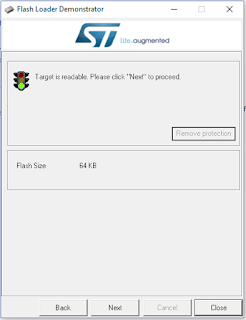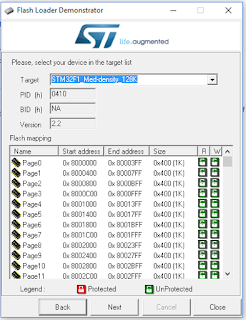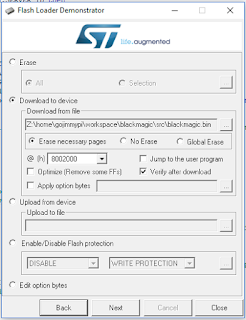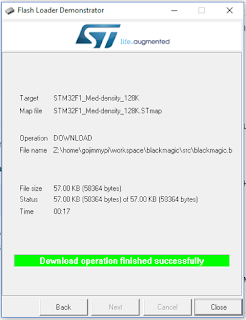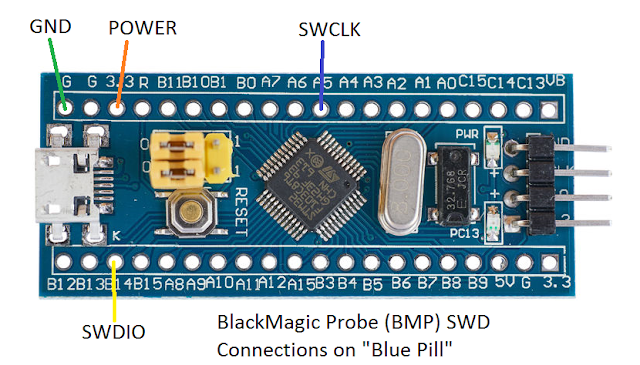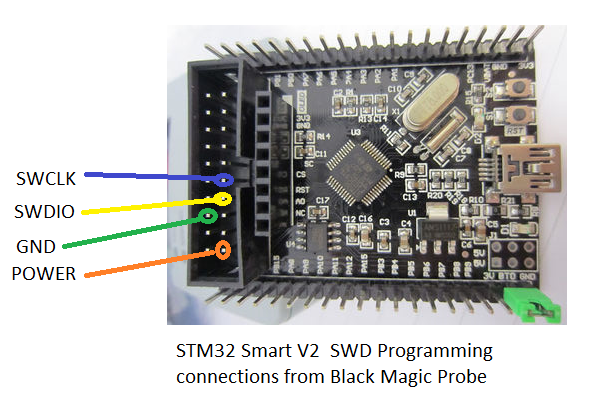Edit: I also tried to use the Maple Mini clone, like this one unsuccessfully; Although I was able to flash the bootloader, my computer did not recognized the device when plugged into the mini-USB connector. (apparently I'm not the only one that was unsuccessful with this).
The instructions there appear very straightforward, however as soon as I saw the some of the text, I realized the guy was using a slightly different distro of linux. So I'll add my notes on using Ubuntu. My Ubuntu is in a VMWare Workstation Virtual Machine running on Windows 10. If you have a similar setup - just don't forget to connect the device as needed from host in VM - Removable Devices. The WSL Ubuntu on Windows that I have still does not yet recognize all USB devices.
Another significant issue for me turned out to the fact that the STM32F103C8T6 is (debatable: see my comment here and noted by someone else here ) only a 64K device (8K for bootloader leaving 56K for app)... and the Black Magic Probe now compiles to 57K. If it was easy, it would be no fun, eh?
To get started, ensure the tool chain is installed:
sudo apt-get update
sudo apt-get install git --assume-yes
sudo apt-get install gcc-arm-none-eabi --assume-yes
sudo apt-get install dfu-util --assume-yes
cd ~/
mkdir -p workspace
cd ~/workspace/
git clone https://github.com/jsnyder/stm32loader.git # download stm32loader
git clone --recursive https://github.com/blacksphere/blackmagic.git # download Black Magic source
#git clone --recursive https://github.com/rogerclarkmelbourne/Arduino_STM32.git # optional, has stm32flash
# optional stm32flash (64 bit version)
mkdir -p tools
cd tools
wget https://github.com/rogerclarkmelbourne/Arduino_STM32/raw/master/tools/linux64/stm32flash/stm32flash
chmod +x stm32flash
cd ~/workspace/blackmagic
make
cd srcmake clean && make PROBE_HOST=stlink
when all looks good, see if you can talk to your board:
sudo apt-get install python-serial
sudo chmod 777 /dev/ttyUSB0
cd ~/workspace/blackmagic/src/
python ~/workspace/stm32loader/stm32loader.py -p /dev/ttyUSB0
it should return a result like this:
Bootloader version 22Chip id: 0x410 (STM32 Medium-density)
Ready to flash! However - note that this is where my instructions are different.
cd ~/workspace/blackmagic/src/
python ~/workspace/stm32loader/stm32loader.py -p /dev/ttyUSB0 -e -w -v blackmagic_dfu.bin
The first time I tried, there was an error (also not the jumper setting needed for BOOT0=1:
Can't init. Ensure that BOOT0 is enabled and reset device
Traceback (most recent call last):
File "/home/gojimmypi/workspace/stm32loader/stm32loader.py", line 436, in
bootversion = cmd.cmdGet()
File "/home/gojimmypi/workspace/stm32loader/stm32loader.py", line 118, in cmdGet
if self.cmdGeneric(0x00):
File "/home/gojimmypi/workspace/stm32loader/stm32loader.py", line 115, in cmdGeneric
return self._wait_for_ask(hex(cmd))
File "/home/gojimmypi/workspace/stm32loader/stm32loader.py", line 88, in _wait_for_ask
raise CmdException("NACK "+info)
__main__.CmdException: NACK 0x0
So just as the error hint said, I pressed the reset button and tried again. Success! Output looks like this:
Bootloader version 22
Chip id: 0x410 (STM32 Medium-density)
Write 256 bytes at 0x8000000
Write 256 bytes at 0x8000100
[..snip..]
Write 256 bytes at 0x8001900
Write 256 bytes at 0x8001A00
Read 256 bytes at 0x8000000
Read 256 bytes at 0x8000100
[..snip..]
Read 256 bytes at 0x8001900
Read 256 bytes at 0x8001A00
Verification OK
DFU loader done! Be sure to move jumpers back to default of "0" and press reset again. The instructions that I followed indicated that the USB device should be disconnected and reconnected. Not much interesting or different there upon re-insertion. Device is still a cp2104 on /dev/ttyUSB0
[927124.098974] usb 2-2.1: new full-speed USB device number 18 using uhci_hcd
[927124.418782] usb 2-2.1: New USB device found, idVendor=10c4, idProduct=ea60
[927124.418783] usb 2-2.1: New USB device strings: Mfr=1, Product=2, SerialNumber=3
[927124.418784] usb 2-2.1: Product: CP2104 USB to UART Bridge Controller
[927124.418785] usb 2-2.1: Manufacturer: Silicon Labs
[927124.418786] usb 2-2.1: SerialNumber: 012345678
[927124.424936] cp210x 2-2.1:1.0: cp210x converter detected
[927124.433135] usb 2-2.1: cp210x converter now attached to ttyUSB0
The first time I ran dfu-util:
dfu-util -d 1d50:6018,:6017 -s 0x08002000:leave -D blackmagic.bin
dfu-util 0.8
Copyright 2005-2009 Weston Schmidt, Harald Welte and OpenMoko Inc.
Copyright 2010-2014 Tormod Volden and Stefan Schmidt
This program is Free Software and has ABSOLUTELY NO WARRANTY
Please report bugs to dfu-util@lists.gnumonks.org
dfu-util: Invalid DFU suffix signature
dfu-util: A valid DFU suffix will be required in a future dfu-util release!!!
dfu-util: No DFU capable USB device available
The reason for the error? I missed the MOST IMPORTANT PART:
Disconnect everything and use the USB to connect.
The Black Magic probe uses the micro USB connector, NOT the Serial TTL! (oops) Sure enough, the device is now listed in Device Manager:
A word of caution here: if you happen to use different sources of power, beware of ground loops. I highly recommend only 1 source of power (either the USB TTY/UART or onboard Micro USB. This could be particularly important if they are on different physical computers, using a USB hub, etc.
When you remove the TTY/UART and connect the USB port on the Blue Pill, you should see something like this with dmesg:
[937218.226791] usb 2-2.1: USB disconnect, device number 22
[937218.227053] cp210x ttyUSB0: cp210x converter now disconnected from ttyUSB0
[937218.227064] cp210x 2-2.1:1.0: device disconnected
[937223.643635] usb 2-2.1: new full-speed USB device number 23 using uhci_hcd
[937223.959267] usb 2-2.1: New USB device found, idVendor=10c4, idProduct=ea60
[937223.959269] usb 2-2.1: New USB device strings: Mfr=1, Product=2, SerialNumber=3
[937223.959271] usb 2-2.1: Product: CP2104 USB to UART Bridge Controller
[937223.959272] usb 2-2.1: Manufacturer: Silicon Labs
[937223.959273] usb 2-2.1: SerialNumber: 01234567
[937223.967154] cp210x 2-2.1:1.0: cp210x converter detected
[937223.973711] usb 2-2.1: cp210x converter now attached to ttyUSB0
[937258.140246] usb 2-2.1: USB disconnect, device number 23
[937258.144289] cp210x ttyUSB0: cp210x converter now disconnected from ttyUSB0
[937258.144327] cp210x 2-2.1:1.0: device disconnected
[938012.539892] usb 2-2.1: new full-speed USB device number 24 using uhci_hcd
[938012.886453] usb 2-2.1: New USB device found, idVendor=1d50, idProduct=6017
[938012.886455] usb 2-2.1: New USB device strings: Mfr=1, Product=2, SerialNumber=3
[938012.886472] usb 2-2.1: Product: Black Magic (Upgrade) for STLink/Discovery, (Firmware v1.6.1-43-g984f8b3)
[938012.886474] usb 2-2.1: Manufacturer: Black Sphere Technologies
[938012.886474] usb 2-2.1: SerialNumber: 76543210
Unfortunately
dfu-util -l
is not happy:
dfu-util 0.8
Copyright 2005-2009 Weston Schmidt, Harald Welte and OpenMoko Inc.
Copyright 2010-2014 Tormod Volden and Stefan Schmidt
This program is Free Software and has ABSOLUTELY NO WARRANTY
Please report bugs to dfu-util@lists.gnumonks.org
dfu-util: Cannot open DFU device 1d50:6017
To confirm the device is there,
lsusb
shows the device as "OpenMoko":
Bus 001 Device 001: ID 1d6b:0002 Linux Foundation 2.0 root hub
Bus 002 Device 025: ID 1d50:6017 OpenMoko, Inc.
Bus 002 Device 003: ID 0e0f:0002 VMware, Inc. Virtual USB Hub
Bus 002 Device 002: ID 0e0f:0003 VMware, Inc. Virtual Mouse
Bus 002 Device 001: ID 1d6b:0001 Linux Foundation 1.1 root hub
You can also view just the device you are looking for with the
-d
parameter:
lsusb -d 1d50:
(don't forget the trailing colon ":"!Ok, not obvious - but the problem here is one again permissions. So run the command with sudo:
sudo dfu-util -l
If successful, the output should look like this:
dfu-util 0.8
Copyright 2005-2009 Weston Schmidt, Harald Welte and OpenMoko Inc.
Copyright 2010-2014 Tormod Volden and Stefan Schmidt
This program is Free Software and has ABSOLUTELY NO WARRANTY
Please report bugs to dfu-util@lists.gnumonks.org
Found DFU: [1d50:6017] ver=0100, devnum=27, cfg=1, intf=0, alt=0, name="@Internal Flash /0x08000000/8*001Ka,056*001Kg", serial="76543210"
Once you can see the device, run dfu-util with sudo:
sudo dfu-util -d 1d50:6018,:6017 -s 0x08002000:leave -D blackmagic.bin
I received an error, that sure looks like an out of memory issue:
dfu-util 0.8
Copyright 2005-2009 Weston Schmidt, Harald Welte and OpenMoko Inc.
Copyright 2010-2014 Tormod Volden and Stefan Schmidt
This program is Free Software and has ABSOLUTELY NO WARRANTY
Please report bugs to dfu-util@lists.gnumonks.org
dfu-util: Invalid DFU suffix signature
dfu-util: A valid DFU suffix will be required in a future dfu-util release!!!
Opening DFU capable USB device...
ID 1d50:6017
Run-time device DFU version 011a
Claiming USB DFU Interface...
Setting Alternate Setting #0 ...
Determining device status: state = dfuIDLE, status = 0
dfuIDLE, continuing
DFU mode device DFU version 011a
Device returned transfer size 1024
DfuSe interface name: "Internal Flash "
Downloading to address = 0x08002000, size = 58364
dfu-util: Last page at 0x080103fb is not writeable
So I found
other instructions relating to STM Discovery as a Black Magic Probe
that indicated dfu_upgrade.bin needed to be loaded (I was willing to try anything!)
sudo dfu-util -d 1d50:6018,:6017 -s 0x08002000:leave -D dfu_upgrade.bin
The results are a bit more promising:
dfu-util 0.8
Copyright 2005-2009 Weston Schmidt, Harald Welte and OpenMoko Inc.
Copyright 2010-2014 Tormod Volden and Stefan Schmidt
This program is Free Software and has ABSOLUTELY NO WARRANTY
Please report bugs to dfu-util@lists.gnumonks.org
dfu-util: Invalid DFU suffix signature
dfu-util: A valid DFU suffix will be required in a future dfu-util release!!!
Opening DFU capable USB device...
ID 1d50:6017
Run-time device DFU version 011a
Claiming USB DFU Interface...
Setting Alternate Setting #0 ...
Determining device status: state = dfuIDLE, status = 0
dfuIDLE, continuing
DFU mode device DFU version 011a
Device returned transfer size 1024
DfuSe interface name: "Internal Flash "
Downloading to address = 0x08002000, size = 6764
Download [=========================] 100% 6764 bytes
Download done.
File downloaded successfully
Transitioning to dfuMANIFEST state
But even with that - I was completely unable to use dfu-util to program the Blue Pill with a 57K blackmagic.bin file. Even after power cycle, reset, etc. So I put the board back into USART programming mode (BOOT0 jumper=1, BOOT1 jumper=0) and used the
ST Flash Loader app
on Windows. The device is initially detected as a 65K device:However on the next screen, apparently you can force it into 128K mode:
The select the blackmagic.bin file, click the "Erase necessary pages", select an address of 0x8002000 and check the "Verify after download" checkbox:
If successful, you should see:
I should point out that several times I received a verify error at this last verify step (I was really convinced I had a 64K-only device). After trying again the next day - things started working immediately and I never again saw the verify error, even after doing a full erase and starting over. YMMV.
Keep in mind that the fact that we are using 128K on a 64K device is rather dangerous. In all likelihood, the manufacturer does an exhaustive memory test: throws away the ones with an error in the first 64K, market the ones with an error in the second 64K as only a 64K STM32f103C 8T6 device, and label the ones with no error as 128K STM32f103CB T6 devices. Although this may be a fun Saturday afternoon project, if you are serious about actually using and depending on a BlackMagic probe for real debugging, consider buying one. (besides, always good to support the developer). When you are elbows-deep in debugging your own project, you really don't want a questionable debugger.
So at this point, I'm not even sure the dfu bootloader is needed, if we are loading the blackmagic.bin file this way.
My particular debugging experiment uses the STM Smart V2 board as a target, and using my STM32 to ST7735 TFT LCD display example with the source on github. This is somewhat of a convoluted setup, as the project is in Visual Studio 2017 (on Windows 10) with the VisualGDB Extension from Sysprogs .
As previously mentioned, I'm running my Ubuntu in a VM, and I have samba installed so that on Windows I can map a drive (C$ is root /):
net use z: \\192.168.1.30\c$ /user:gojimmypi
Debugging connections from Blue Pill board configured as a Black Magic Probe (micro usb connected to Ubuntu):
Connecting the Blue Pill Black Magic Probe to an STM Smart V2 board :
cd ~/workspace
git clone https://github.com/gojimmypi/STM32-ST7735.git
then open the solution Z:\home\gojimmypi\workspace\STM32-ST7735\STM32-ST7735.sln in Visual Studio and compile.
cd ~/workspace/STM32-ST7735/STM32-ST7735
arm-none-eabi-gdb -d ./ -f ~/workspace/STM32-ST7735/VisualGDB/Debug/STM32-ST7735 -tui
ls /dev/ttyACM* -al
then in GDB, connect with the first ttyACM[n] device (the second one is a serial port). Mine were originally
ttyACM0 and ttyACM1, but then later changed to ttyACM1 and ttyACM2 (no idea how/why). I even saw an instance while debugging that ttyACM1 changed to ttyACM0 yes leaving me with (ttyACM0 and ttyACM2
).Weird.Anyhow, here are some useful GDB commands to get started:
target extended-remote /dev/ttyACM1
monitor swdp_scan
attach 1
If successful you should see something like this:
GNU gdb (7.10-1ubuntu3+9) 7.10
Copyright (C) 2015 Free Software Foundation, Inc.
License GPLv3+: GNU GPL version 3 or later
This is free software: you are free to change and redistribute it.
There is NO WARRANTY, to the extent permitted by law. Type "show copying"
and "show warranty" for details.
This GDB was configured as "--host=x86_64-linux-gnu --target=arm-none-eabi".
Type "show configuration" for configuration details.
For bug reporting instructions, please see:
.
Find the GDB manual and other documentation resources online at:
.
For help, type "help".
Type "apropos word" to search for commands related to "word"...
Reading symbols from /home/gojimmypi/workspace/STM32-ST7735/VisualGDB/Debug/STM32-ST7735...done.
(gdb) target extended-remote /dev/ttyACM1
Remote debugging using /dev/ttyACM1
(gdb) monitor swdp_scan
Target voltage: unknown
Available Targets:
No. Att Driver
1 STM32F1 medium density
(gdb) attach 1
Attaching to program: /home/gojimmypi/workspace/STM32-ST7735/VisualGDB/Debug/STM32-ST7735, Remote target
0x08001514 in SetSysClockTo72 () at system_stm32f10x.c:993
(gdb)
sample
Resources, Inspiration, Credits, and Other Links:
- Converting an STM32F103 board to a Black Magic Probe (Param Aggarwal)
- 1bitsquared Black Magic Probe (BMP)
- 1bitsy and Black Magic Probe on Kickstarter
- https://github.com/blacksphere/blackmagic
- blackmagic stlink clone support issue #62
- Atmel DFU Bootloader Datasheet
- STM32F103x8 / STM32F103xB data sheet
- stm32loader (jsnyder repo on github)
- STM Discovery as Black Magic Probe
- stm32duino - Black Magic Probe on an stm32f103c8
- stm32duino - dfu-util: Cannot open DFU device
- STM32 Flash loader demonstrator (UM0462)
- wiki.stm32duino Blue Pill
- Writing internal flash with dfu-util to set EEPROM defaults
- STM32 Smart V2.0
- https://github.com/rogerclarkmelbourne/Arduino_STM32
- wifi4things - STM32F103C8T6 Blue Pill Board with Arduino IDE on Linux (pics broke, but interesting info)
- https://wiki.paparazziuav.org/wiki/STLink
Copyright (c) gojimmypi all rights reserved. Blogger Image Move Cleaned: 5/3/2021 1:35:53 PM





